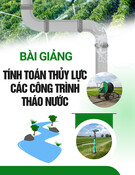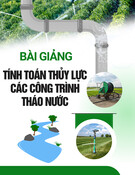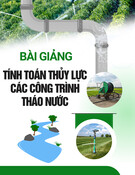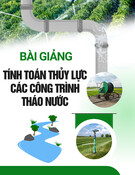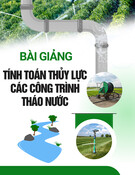
Journal of Science and Transport Technology Vol. 3 No. 4, 1-9
Journal of Science and Transport Technology
Journal homepage: https://jstt.vn/index.php/en
JSTT 2023, 3 (4), 1-9
Published online 29/11/2023
Article info
Type of article:
Original research paper
DOI:
https://doi.org/10.58845/jstt.utt.2
023.en.3.4.1-9
*Corresponding author:
E-mail address:
truong.dinhcong@hust.edu.vn
Received: 02/09/2023
Revised: 20/11/2023
Accepted: 22/11/2023
Numerical analysis of aerodynamic and
structure characteristics of an autonomous
unmanned flying car for high-rise building
rescue operations in urban area
Cong-Thanh Nguyen1, Hoang-Quan Chu2, Thai-Son Vu1, Xuan-Truong Le1,
Cong-Truong Dinh1,*
1School of Mechanical Engineering, Hanoi University of Science and
Technology, No 1 Dai Co Viet St. Hai Ba Trung Dist., Hanoi 11615, Vietnam
2Faculty of Aerospace Engineering, Le Quy Don Technical University, No. 236
Hoang Quoc Viet St., Bac Tu Liem Dist., Hanoi 11917, Vietnam
Abstract: Using numerical commercial software, this article presents a type of
autonomous unmanned flying car capable of saving people in burning high-
rise buildings in urban areas. This kind of flying vehicle is maneuverable and
fast, and it has the ability to anchor to the building balconies to receive people
in distress. Initial, a computational simulation is performed to investigate the
aerodynamic properties of the propeller without and with a guard ring. A full-
scale model evaluation based on Buckingham-Pi theory is then performed to
evaluate the aerodynamic and structural characteristics of the proposal.
Numerical simulation results show that the proposed design is feasible.
Keywords: ANSYS, Flying car, Rescue operations, Aerodynamic, Structure.
1. Introduction
Nowadays, urbanization and population
growth speed are increasing rapidly around the
world. This leads to numerous problems regarding
conventional transportation infrastructures and
vehicles, notably congestion [1]. Thus, flying cars
come into the prospect as an alternative to traditional
automobiles. Most flying car designs up to date are
based on the quadcopter configuration, commonly
found in unmanned drones. This is because
quadcopters have very high mobility. They can take
off and land vertically at high speed and in small
spaces. Therefore, quadcopters, or unmanned
drones in general can be used as a means to conduct
search and rescue operations [2]. On the other way,
saving victims from dangerous situations can be
done quickly thanks to flying cameras.
In fact, the idea is to implement a flying car with
the capability to carry passengers to conduct rescue
operations, ideally in tall buildings. In the case of a
fire in the high level of a building and the victim is
trapped, the vehicle can be dispatched, rapidly to the
level of the incident, and people can enter and
descend to ground level unharmed. This helps the
process to become much earlier and thus ensures
the safety of the victim. The aspect of this design is
very promising as more and more tall building
continues to rise in major cities in Vietnam [3].
2. Experimental Setup
2.1. Propeller Description
Figure 1 illustrates a propeller HQ 8x4x3
Prop, which is rotated by an electric motor XING2
3106 FPV Motor Unibell, is provided by the same
company iFlight FPV [4, 5]. This propeller having 3

JSTT 2023, 3 (4), 1-9
Nguyen et al.
2
blades, 8-inch diameter (203.2 mm), and a pitch
angle of 4o produces thrust force, which is
measured with each corresponding throttle level. In
this case, the throttle input signal is provided by the
Frsky Taranis X9D Plus 2019 radio transmitter as
PWM pulse vary from 1000 μs being zero throttle
to 2000 μs being maximum [6].
Fig. 1. Propeller and electric motor
Fig. 2. Test bench setup
Table 1. Experimental results of the propeller
Throttle (μs)
RPM
Thrust (No guard) (kg)
1100
3614
0.08
1200
6085
0.25
1300
8928
0.53
1400
11128
0.86
1500
13147
1.19
1600
14985
1.53
1700
17042
1.79
1800
17528
1.85
1900
18557
2.01
2000
19085
2.13
2.2. Thrust Measurement
Figure 2 displays an experimental setup
measure propeller thrust at Propulsion Systems
Laboratory, Hanoi University of Science and
Technology. Battery, ESC, and servo are
connected to a propeller with electric motor like
controlling a regular drone. A loadcell that is fixed
on a test stand to place the propeller is combined
with an Arduino board to measure propeller thrust.
Finally, the display of results through Arduino IDE
coding software on the computer. The results
obtained are presented in Tab.1.
Table 2. Parameters for the prototype model
Parameter
Value
Dimensions
744 x 524 x 368 mm
Total weight
2.5 kg
Max payload
1 kg
3. Numerical Analysis
3.1. Model Design Description
When designing a UAV, the most important
factor that comes to mind is the maximum payload
that it can carry. Research is considered in
Vietnam, where the average weights of
Vietnamese men and women for the age from 45
to 54 are 61.1 kg and 55.4 kg, respectively [7].
Thus, it is decided that 120 kg is the maximum
value that the craft can carry. Therefore, the vehicle
is capable of carrying one adult passenger with
safety. The factor of safety needs to be reflected as
well. According to reference [8], the chosen safety
factor is 1.5. With the vehicle being used for rescue
operations, the safety factor will be 1.6 to ensure
total safety for the passengers. According to the
estimated max take-off weight is around 200kg,
therefore the max thrusts needed will be 400 kg.
The maximum altitude that the craft can
reach is 500m, which allows it to reach an 80-store
tall building. In many cases, this ensures the
vehicle can access traditional apartments with 20
or 30 levels. Flight time is around 15 to 20 minutes
for any operations to go smoothly. This is important
when comes to choosing the right battery and
propulsion systems.

JSTT 2023, 3 (4), 1-9
Nguyen et al.
3
For the craft to be able to carry out its
missions, a docking mechanism is required for the
attachment to the balcony of any apartment. The
craft can stay stationary during the dock for the
passenger to come in. Grippers with pneumatic
actuators are taken into consideration for their
strength while being lighter than hydraulics.
Besides that, the side of the craft can act as a
platform for the passenger to step in.
(a) Flying car prototype
(b) Docking mechanism
Fig. 3. Prototype model with docking mechanism
For the materials, carbon fiber is a well-
known element in UAV fabrication with its
outstanding properties of lightweight and high
durability [9]. However, with the restriction of high
prices, for creating a small version of the model,
the frame material is resolved to pine wood, which
is also lightweight in combination with high
stiffness, though slightly heavier. Its performance is
suitable for frame construction [10].
To perform simulations and experimental
validations of the design, the creation of a scale
model is needed as it is easier to perform, saving
money and resources. The model is a quadcopter
with an H-frame configuration (Fig. 3a). The H-
frame along with the X-frame are the most common
configurations used for this type of aircraft. The
reason the H-frame was chosen is that it had a
stretched rectangular structure, which can
accommodate a lot of space in the middle for the
payload, as well as any electronic components and
batteries [11]. The structure of the frame is also
very simple with only four beams, making it very
lightweight. The inspiration for the design is loosely
based on the Jetson One, the first affordable
personal eVTOL on the market [12]. The
parameters for the research prototype model as
shown in Tab.2. The gripper arms and the side
plate will have servo as actuators for quick action
and lightweight (Fig. 3b).
3.2. Fundamental Theory
To validate the design concept via a
prototype model, Buckingham Pi theorem is used
to create a dynamic similitude between the two of
them, by creating dimensionless ratios known as Pi
group. Coutinho et al had made a review on the
subject and its application in engineering [13].
Hoblet et al. had used the theorem to develop a
scale model car for the design of a steering
controller to implement into real vehicle [14].
Veeranjaneyulu et al had also applied the theorem
in their design of an aerial hoverboard [15]. In this
article, the Pi groups are created by identifying key
dimensional physical parameter than applying
dimension analysis to form the dimensionless
ratios. In our case, the following are required: Air
density (ρ), Angular velocity of the propeller (ω),
Gravitational acceleration (g), Maximum thrust (T),
Rotor diameter (d), and Total weight (m). These are
the basic parameters for analyzing the dynamics of
a quadcopter based on helicopter aerodynamics
[16]. From this parameters, three dimensionless Pi
groups are form:
Π1=T
ρd4ω2;Π2=m
ρd3;Π3=gd
ω2 (1)

JSTT 2023, 3 (4), 1-9
Nguyen et al.
4
The first Pi group illustrates the relation of
thrust, the second one being for weight and the
third one for gravitational force. With this, relation
is established between the two models. To create
a full-scale vehicle that is dynamically like the
prototype, the Pi groups of the two must equal.
From this, we can perform experimental research
on the prototype model and optimize the design of
the full-scale version.
4. Results and Discussion
4.1. Grid Dependency Test
In the present study, the governing
differential equations, including continuity,
Reynolds-averaged Navier-Stokes (RANS), and
energy equations, are solved numerically to study
the flow characteristics of the model [17-21]. The
simulations are conducted using the commercial
software ANSYS Fluent 19.1 [22].
As remarked above, the propeller used for
the flying car sub-scale model is the HQ 8x4.5x3
with diameter D = 8 inch (203.2 mm). For geometry
conditions, the rotating domain of the propeller has
diameter of 1.04D, heigh of 0.4D. The optimal
value of those is 1.1D and 0.4D according to Kutty
and Rajendran [23] but we reduce it because the
drone has a propguard with 1.1D in diameter and
40 mm in height. For this analysis, the propguard
is not required. The static domain is a cylinder of
10D in diameter and 10D in height (Fig. 4a).
For the best results, it is necessary to assess
which turbulence model is the best for the problem.
Simulations will be performed with the Spalart-
Allmaras (S-A), k-epsilon (k-ε) and SST k-omega
(SST k-ω) model on a single propeller. The result is
validated with the experimental test bench results
(Tab.1) as done in “Experimental setup” part.
The mesh is performed using the
tetrahedrons method (Fig. 4b). A 10 layers inflation
is put at the surface of the propeller with the 1st
layer thickness at 0.02 mm and a growth rate of
1.2. With this setup, the value of y+ number is 0.73.
The results illustrate that the difference
between the thrust values is insignificant (Fig. 5).
The S-A has a 5% higher value than the ones of
the other twos. The difference between k-ε and
SST k- ω is roughly 2%. Both of this model have a
6% decrease compared to the experiment results.
Due to the nature of the problem, accurate analysis
is needed in near wall regions such as propeller or
the model cover surface, the SST k- ω is chosen
for the entire CFD analysis.
(a) Geometry
(b) Meshing
Fig. 4. Rotating domain without propguard.
Fig. 5. Numerical and experimental results.
4.2. Propeller Analysis
With the design having a propeller guard
(Fig. 6a), it is necessary to assess its affect to the
performance of the propeller in terms of generated
thrust to validate the flying capability of the model.
The mesh generation and boundary conditions are
the same as the no guard simulation (Tab. 3).
The guarded propeller mesh is illustrated in
Fig. 6b. The thrust results (Fig. 7) can be seen from
the graph. It is easy to notice that there are some
noticeable differences in the results. There is a
10% difference between the values of the open
propeller simulation to those of the test. Besides
that, there is also a 10% drop in force in the case
of propeller guard compared to open propeller. This
is acceptable as guard is mainly for protection

JSTT 2023, 3 (4), 1-9
Nguyen et al.
5
purposes and the generated force is still sufficient
for take-off. The craft with the maximum take-off
weight of 3.5 kg will be able to operate at a throttle
level of 50% to 60% with the thrust of 1 kg per
propeller, leading up to 4 kg total.
The velocity and pressure contours show the
values distributed around the propeller blade area
(Fig.8-9). While high velocity values are
concentrated in the blade tip region, in the propeller
hub is the low velocity area (Fig.8). The airflow
passing through the propeller zone is accelerated
to about 50-60 m/s (i.e., the white area just below
the rotating zone). There is a small sector of high
pressure at the blade leading edge and a large
zone of low pressure on the blade suction side
(Fig.9). This pressure difference explains why the
blades create thrust. These results are in perfect
agreement with the basics of aerodynamics.
(a) Geometry
(b) Meshing
Fig. 6. Rotating domain with prop guard
Table 3. Mesh statistics of two simulation models
Mesh statistics
Nodes
Elements
No guard
190,960
691,734
With guard
224,619
869,277
Fig. 7. Thrust relation to the RPM of the motor.
Fig.8. Velocity contour of the domain
Fig. 9. Pressure contour at 50% radius
4.3. Full Model Simulations
With the propeller fully capable to lift the UAV,
the entire body simulations are conducted to
validate the design aerodynamic, so that
improvement can be made to the model. The static
domain dimension is set to ensure that the distance
between the model and the ground is greater than
5D to avoid ground effect (Fig.10a). All the mesh
setup is identical to those for the propellers
(Fig.10b). The inlet velocity is 5 m/s, and the
propellers will be spinning at 14,987 RPM, which is
equivalent to 50% throttle.
The pressure on the body is mainly focus on
the roof at 18.18 Pa (Fig.11a). In addition, the
simulation results show that there are some
vortices that formed under the body (Fig.11b). This
is a major factor that contribute to the drag and
optimization is needed. The propeller generates an
8.8 N of force individually, creating a total thrust of
35.2 N, which is sufficient for operation. Moreover,




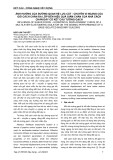

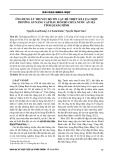

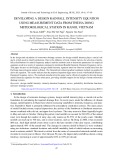
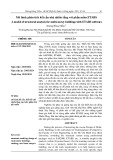
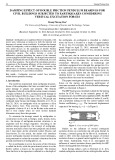







![Bài giảng Quản lý vận hành và bảo trì công trình xây dựng [chuẩn nhất]](https://cdn.tailieu.vn/images/document/thumbnail/2025/20251006/agonars97/135x160/30881759736164.jpg)


